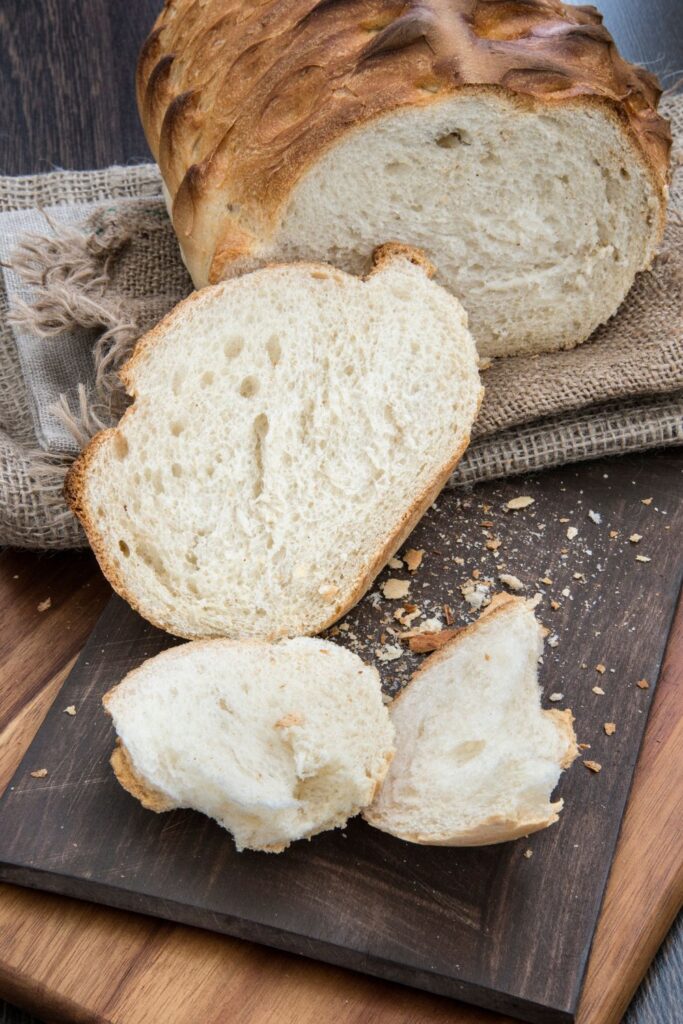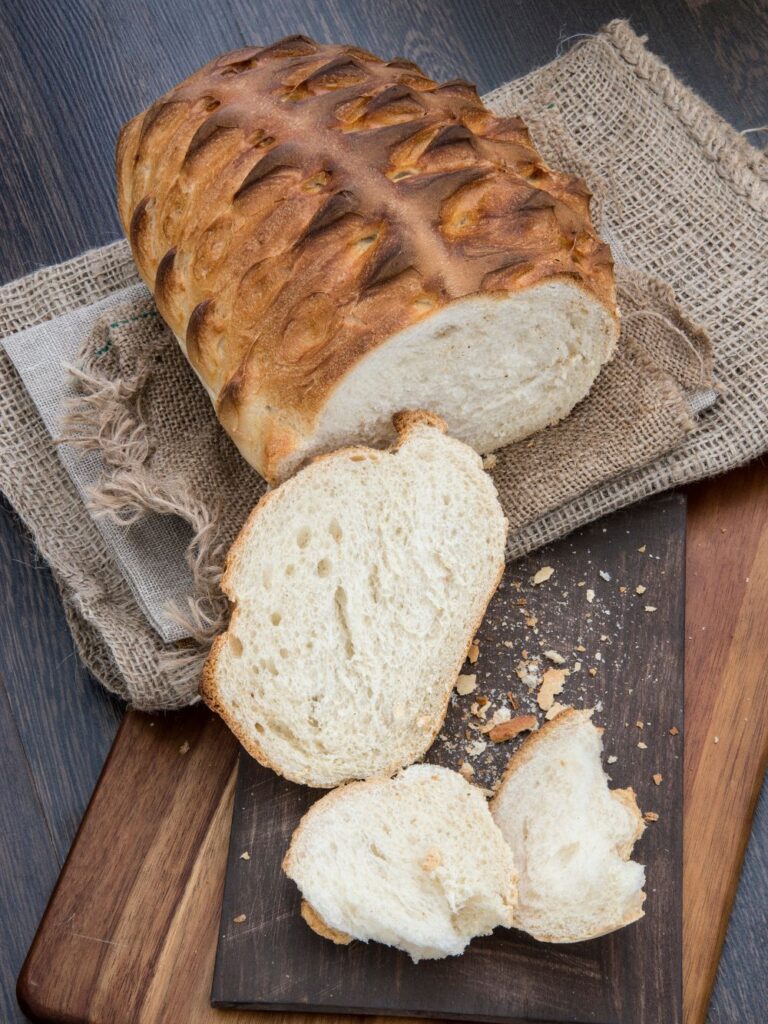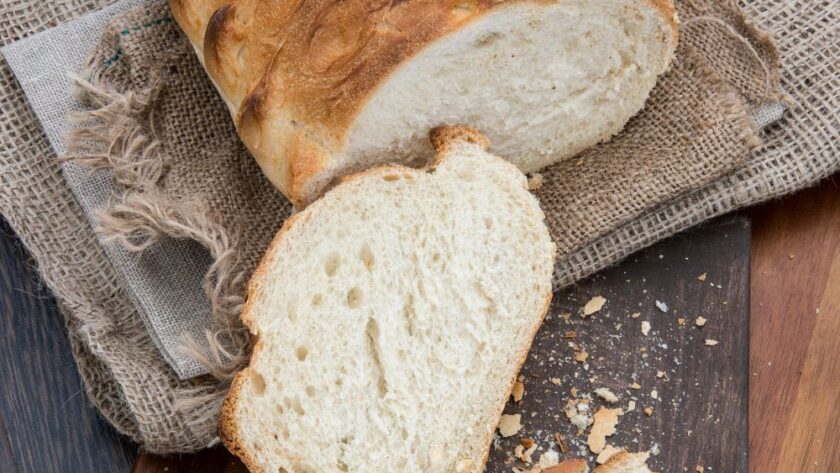There’s a kind of stillness that comes with making a farmhouse loaf. No noise, no rush. Just you, the gentle stretch of dough, the smell of warm yeast, and that quiet anticipation as the loaf rises, slowly, patiently. Mary Berry’s Farmhouse Loaf is one of those recipes that holds your hand through the process. Nothing flashy or complicated. Just honest ingredients, done properly.
Using very strong white bread flour, a touch of softened butter, instant yeast, and tepid water, this loaf bakes up golden and proud — with that lovely springy crumb and a crackling crust that makes the softest sound when you tear it. Whether you’re serving it warm with jam, toasting it for breakfast, or dunking it into soup, it delivers that feeling of home.
Ingredients List
- 600g very strong white bread flour, plus extra for dusting
(The strength of the flour gives it that classic chewy structure.) - 2 tsp fine sea salt
(Balances flavour; don’t skip it.) - 1 tsp caster sugar
(Feeds the yeast and adds subtle sweetness.) - 1½ tsp instant yeast — I use Dove’s Farm
- 50g softened butter (about 4 tbsp)
(Enriches the dough and adds a touch of tenderness.) - 350ml tepid water
(Should feel like a warm bath — not hot.)
How to Make It (Instructions)
Make the Dough
- In a large bowl, mix flour, salt, sugar, and yeast. Add the softened butter.
- Make a well in the middle and pour in the tepid water gradually, stirring until a rough dough forms.
- Tip it onto a floured surface. Knead for 10–12 minutes by hand until smooth and elastic.
(Or use a mixer: 1–2 mins on low, 8–10 mins on medium.) - Check readiness with the windowpane test — stretch the dough gently between your fingers; it should form a thin, translucent sheet.
First Rise (Prove)
- Place dough in a lightly oiled bowl, cover with a damp cloth or cling film.
- Leave in a warm place for 1½ hours, or until doubled in size.
(I usually place mine near the boiler — it’s old, but still the best spot for rising dough.)
Shape the Loaf
- Turn the dough out onto a lightly greased surface.
- Press into a rough rectangle, then roll it up tightly from the short edge.
- Place seam-side down into a greased loaf tin. Pinch the ends gently to neaten.
Second Rise
- Cover the tin and let it rise again for 45 minutes, until puffed and peeking over the tin’s edge.
Bake with Steam
- Cool on a wire rack. The hardest part is waiting.
- Preheat oven to 230°C (210°C fan / 450°F). Place an empty metal pan on the bottom rack.
- Slash the top of the loaf three times at a 45° angle. Lightly dust with flour.
- Just before baking, pour 1 cup of hot water into the pan below for steam. Carefully shut the oven door.
- Bake for 10 minutes at 230°C, then lower to 200°C (180°C fan / 350°F) and bake for another 30–35 minutes.
- Check doneness: the loaf should be golden, sound hollow when tapped, and register 90–95°C (194–203°F) inside.

Common Mistakes
Why is my loaf too dense?
You may have under-kneaded or used cold water. Proper kneading develops gluten for that airy interior.
Why didn’t my dough rise well?
Check your yeast! If it’s expired or stored poorly, it won’t rise. Tepid water helps activate it too.
Why did my crust turn too dark?
Your oven might run hot. Consider checking with a thermometer or covering the loaf with foil halfway through.
Why does my dough stick everywhere?
Be generous with oiling your surfaces — especially during shaping. Dry hands help too.
Storage and Reheating Tips
- Room Temp: Wrap in a clean tea towel or store in a bread box for 2–3 days.
- Fridge: Not recommended — it dries the bread.
- Freezer: Slice and freeze in a zip-top bag. Keeps for up to 2 months.
To Reheat:
- Oven: 10 minutes at 180°C (for whole or sliced loaf).
- Microwave: 20–30 seconds per slice (wrap in paper towel).
- Air Fryer: 4–5 minutes at 160°C for a soft-centred slice with crispy edges.
What to Serve With It
- A soft pat of salted butter and strawberry jam — the classic British breakfast.
- Scrambled eggs and smoked salmon — for something a touch posher.
- A deep, brothy stew or homemade tomato soup — perfect for dunking
FREQUENTLY ASKED QUESTIONS
Can I use all-purpose flour instead?
You can, but the loaf will be less chewy and structured. Strong bread flour really makes a difference here.
What if I don’t have a loaf tin?
Shape it into a round and bake on a tray — you’ll have a rustic boule-style loaf.
Can I make this dough the night before?
Yes. Let it rise in the fridge overnight for the first prove. Bring it to room temp before shaping.
Can I add seeds or grains?
Absolutely — sprinkle flaxseeds, sunflower seeds, or oats into the dough or over the top before baking.
Try More Mary Berry Recipe:
- Mary Berry Bread And Butter Pudding
- Mary Berry Wheaten Bread Recipe
- Mary Berry Chocolate Chip Shortbread
Nutrition Fact:
- Calories: 162kcal
- Carbohydrates: 28g
- Protein: 5g
- Fat: 3g
- Saturated Fat: 2g
- Polyunsaturated Fat: 1g
- Monounsaturated Fat: 1g
- Cholesterol: 7mg
- Sodium: 315mg
- Potassium: 49mg
- Fiber: 1g
- Sugar: 1g Calcium: 8mg
- Iron: 1mg

Mary Berry Farmhouse Loaf Recipe
Description
Mary Berry Farmhouse Loaf is crafted with very strong white bread flour, fine sea salt,caster sugar, instant yeast (Dove’s Farm),softened butter, and 350 ml tepid water. This straightforward recipe demands just under 2 hours, yielding a delightful loaf ready to serve.
Ingredients
Instructions
- In a large bowl, combine flour, salt, sugar, yeast, and butter.
- Make a well, pour in water gradually, and mix into a dough.
- Knead for 10–12 minutes by hand or 8–10 minutes in a stand mixer.
- Place in a greased bowl, cover, and let rise for 1½ hours.
- Turn out, shape into a loaf, and place in greased loaf tin.
- Cover and rise again for 45 minutes.
- Preheat oven to 230°C and place an empty pan inside.
- Slash top, dust with flour, and pour hot water into pan for steam.
- Bake 10 mins at 230°C, then 30–35 mins at 200°C.
- Cool on a wire rack before slicing

